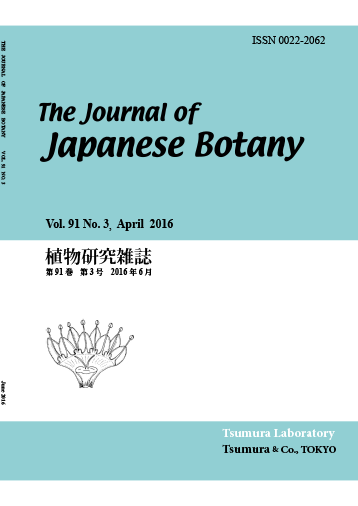
- |<
- <
- 1
- >
- >|
-
Article type: cover
2016Volume 91Issue 3 Article ID: 91_3_10661
Published: June 20, 2016
Released on J-STAGE: October 21, 2022
JOURNAL FREE ACCESSDownload PDF (446K) -
Supatthra Sangnark, Sittichoke Prasarn, Boonmee Phokham, Pornpimon ...Article type: Originals
2016Volume 91Issue 3 Pages 133-140
Published: June 20, 2016
Released on J-STAGE: October 21, 2022
JOURNAL FREE ACCESSTwo new species, Caulokaempferia kayinensis Picheans. & Sangnark and C. monensis Picheans. & Sangnark (Zingiberaceae), are described. This is the first report of the genus from Myanmar. The sessile inflorescence of C. kayinensis, hidden in the uppermost two leaf sheaths, is unique among the yellow-flowered group of the genus. The long ligule, ovate bract, and the bract-formation on inflorescence are characteristic of C. monensis. Full descriptions, together with ink line-drawings with water-color and photographic illustrations, of these new taxa are given.
View full abstractDownload PDF (1384K) -
Mikio KobayashiArticle type: Originals
2016Volume 91Issue 3 Pages 141-159
Published: June 20, 2016
Released on J-STAGE: October 21, 2022
JOURNAL FREE ACCESSJapanese dwarf bamboos, the Sasa-group, Arundinariinae have four styles of culm branching that characterized with culm-sheath behavior. First is the intravaginal branching style, where the branch(es) emerges and grows within the mother culm-sheath. This occurs among genera Pleioblastus, Pseudosasa, and Sasa except for a portion of the Sasa nipponica-S. palmata complex. Second is the ‘transfer style’ where the mother culm-sheath entirely transfers to embrace new branch(es), the base of which breaks at the marginal side, occurring among genera Sasamorpha, Neosasamorpha, and a part of Sasaella. Third is the extravaginal style where branches break through the base of the axillary bud-side of the mother culm-sheath, occurring among only a portion of Sasaella and the majority of the S. nipponica-S. palmata complex. Fourth is the mixed style of extravaginal and transfer within a same culm, occurring in a part of the genus Sasaella. Thus, the putative intergeneric hybrid taxon Sasaella between genera Pleioblastus and Sasa, Sasamorpha, or Neosasamorpha provides a distinctive branching style from the parental genera, suggested that the branching style characterized with culm-sheath behavior provides a useful key to classify the Japanese dwarf bamboos of the Sasa-group.
View full abstractDownload PDF (6980K) -
Dipanwita Banik, Priyankush Protim BoraArticle type: Originals
2016Volume 91Issue 3 Pages 160-178
Published: June 20, 2016
Released on J-STAGE: October 21, 2022
JOURNAL FREE ACCESSIn the myristicaceous genera Horsfieldia Willd. and Endocomia W. J. de Wilde, four taxa are recognized in India, viz., Endocomia macrocoma (Miq.) W. J. de Wilde subsp. prainii (King) W. J. de Wilde and Horsfieldia irya (Gaertn.) Warb., H. amygdalina (Wall.) Warb. var. amygdalina and H. kingii (Hook. f.) Warb. Morphological characters of Horsfieldia and Endocomia were described based on our specimens collected during 2000 and 2012–2014 in India and previous specimens kept in Indian herbaria. Keys to the taxa are provided for easy identification. All the taxa are listed with synonyms, type specimens, descriptions, distribution, phenological data, vernacular names and examined specimens. Endocomia macrocoma subsp. prainii is newly recorded in Assam and Tripura states.
View full abstractDownload PDF (3200K) -
Aabid Hussain Mir, Krishna Upadhaya, Clarence G. KhonglahArticle type: Notes
2016Volume 91Issue 3 Pages 179-183
Published: June 20, 2016
Released on J-STAGE: October 21, 2022
JOURNAL FREE ACCESSMitrastemon yamamotoi Makino (Mitrastemonaceae) is the only species of the genus found in the state of Meghalaya, North East India. The present study is a recollection of the species for the second time after a gap of about 45 years. In addition to its detailed taxonomic description, habitat characterization, threats operating on the species and related conservation implications are also discussed.
View full abstractDownload PDF (912K) -
Hideaki Ohba, Hiroshi IkedaArticle type: Notes
2016Volume 91Issue 3 Pages 184-185
Published: June 20, 2016
Released on J-STAGE: October 21, 2022
JOURNAL FREE ACCESSTwo new combinations of the infra-specific taxa of Cerasus itosakura (Siebold) Masam. & Suzuki (Rosaceae) are proposed.
View full abstractDownload PDF (287K) -
Yuya Inoue, Harumori Kubo, Shinji Uchida, Seiji Mukai, Hiromi Tsu ...Article type: Notes
2016Volume 91Issue 3 Pages 186-190
Published: June 20, 2016
Released on J-STAGE: October 21, 2022
JOURNAL FREE ACCESSSyrrhopodon tosaensis Cardot is reported from Miyajima Isl. in Hiroshima Pref., SW Japan for the first time since the early 1970s. Information on the habitat and the distribution for this species on Miyajima Isl. is given.
View full abstractDownload PDF (1195K) -
Alexander B. DoweldArticle type: Notes
2016Volume 91Issue 3 Pages 191-192
Published: June 20, 2016
Released on J-STAGE: October 21, 2022
JOURNAL FREE ACCESSJunior homonyms of extant species, fossil Styrax laevigatus Miki 1941 (Styracaceae; non Aiton 1789) and fossil Styrax rugosus Miki 1941 (non Kurz 1871), are replaced with new names respectively, S. mikii Doweld and S. plionipponicus Doweld. Lectotype specimens (based on fruits) for S. mikii Doweld and neotype (based on seeds) for S. plionipponicus Doweld are designated for the first time for fossil species.
View full abstractDownload PDF (278K) -
Hiroo KanaiArticle type: Book review
2016Volume 91Issue 3 Pages 193
Published: June 20, 2016
Released on J-STAGE: October 21, 2022
JOURNAL FREE ACCESSDownload PDF (274K) -
Hiroo KanaiArticle type: Book review
2016Volume 91Issue 3 Pages 193
Published: June 20, 2016
Released on J-STAGE: October 21, 2022
JOURNAL FREE ACCESSDownload PDF (274K) -
Hiroo KanaiArticle type: Book review
2016Volume 91Issue 3 Pages 193-194
Published: June 20, 2016
Released on J-STAGE: October 21, 2022
JOURNAL FREE ACCESSDownload PDF (334K) -
Hiroo KanaiArticle type: Book review
2016Volume 91Issue 3 Pages 194
Published: June 20, 2016
Released on J-STAGE: October 21, 2022
JOURNAL FREE ACCESSDownload PDF (241K) -
Article type: Errata
2016Volume 91Issue 3 Pages 194
Published: June 20, 2016
Released on J-STAGE: October 21, 2022
JOURNAL FREE ACCESSDownload PDF (241K)
- |<
- <
- 1
- >
- >|